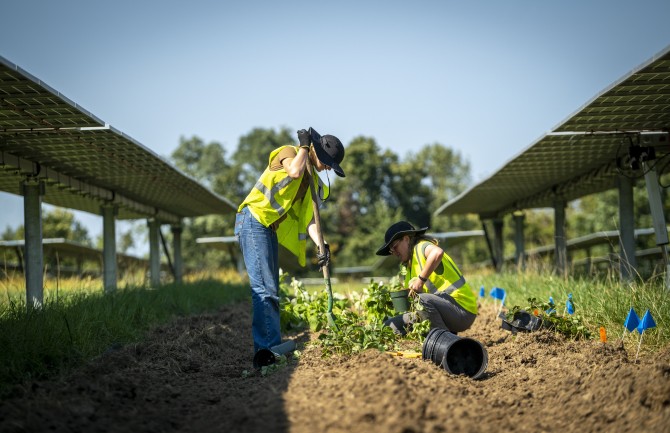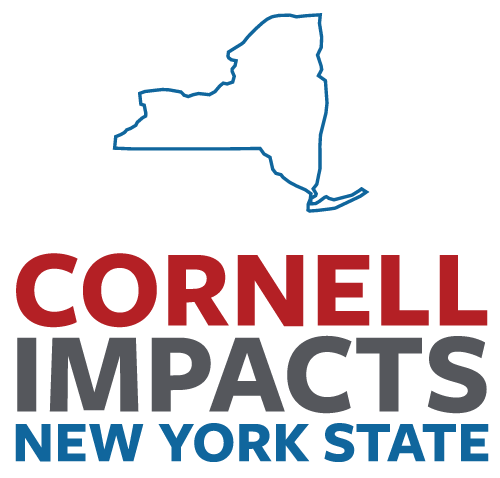Solar solutions: Agrivoltaics offer array of options for farmland use

Cornell graduate student Dana Russell plants strawberries at a commercial solar farm in Ravena, New York. It is one of the active agrivoltaic research projects – the idea of growing crops while harnessing the sun’s energy – around the state.
Solar solutions: Agrivoltaics offer array of options for farmland use
By Krisy Gashler
Not everyone is excited about New York’s rapid solar expansion.
The buildout of solar energy infrastructure across the state has become an issue of grave concern for many farmers and those worried about the state’s agricultural communities. The U.S. Department of Energy estimates that 10 million acres will be needed to meet solar energy production goals by 2050, and American Farmland Trust estimates 80% of that could be built on agricultural lands. A Cornell study found that approximately 84% of land identified as suitable for future solar development in New York state is agricultural.
“One of the big questions is always, how will landowners, both farmers and non-farmers, respond to solar leasing opportunities?” said Rich Stedman, professor of natural resources and the environment in the College of Agriculture and Life Sciences (CALS). “Some people fear this will be the death of farming, that people are going to lease their acres for solar panels and that’ll be it – it will be an ‘exit strategy’ and that land will be lost to production. Other people have hypothesized that the additional income will enable people who want to stay in farming to do so.”
Stedman studies the social science dynamics of energy transformations, and has conducted surveys and focus groups with farmers and other landowners. One recently completed survey of New York state landowners living near transmission lines and electricity substations found that farmers were more opposed than non-farmers to large-scale solar development in their area, and that farmers were more likely than non-farmers to be approached by solar developers but less likely to lease their land.
The research also found that among farmers who have leased their land, about half expect to continue producing agricultural products on the land with solar panels – a process called agrivoltaics, which has seen a great leap in Cornell research activity.
In 2024, with $1 million in initial support from New York state, CALS established the Agrivoltaics Research Program to bring together dozens of researchers across campus and external partners to explore the engineering, agronomics, economics, policy and social science of agrivoltaics.
“So there certainly is interest in this idea of agrivoltaics, but people want a lot more information about what that would actually mean for their farms,” Stedman said. “Because agricultural land is so ‘in the crosshairs’ with utility-scale solar, it’s very important that we figure out how to avoid prime farmland and how to work with farmers in a way that honors what they actually do and want to do.”
An equally important factor, according to Max Zhang, the Irving Porter Church Professor of Engineering in Cornell Engineering and Provost’s Fellow for Public Engagement: What will it cost energy consumers?
“The cost-effectiveness of agrivoltaics systems is crucial to market adoption and the overall energy transition,” said Zhang, whose team conducted the New York state land-use analysis. “As solar becomes a major source of electricity generation in the near future, we must ensure electricity remains affordable for the public.”
‘The missing link in the whole system’
Elizabeth Ryan ’82 owns Hudson Valley Farmhouse Cider and Stone Ridge Orchard, where she grows a wide variety of vegetables and fruits, including 1,000 acres of apples. Ryan is in early negotiations to incorporate solar panels into her orchards.
“Agrivoltaics are the missing link in the whole system, because they allow growers to dual-crop, so to speak: harvest the sun and harvest plants or graze livestock under the panels,” she said. “I’m super excited about this concept and see it as the next frontier.”
Solar industry research has found that adjustable-tilt solar panels above a vineyard reduced heat stress on the crop by providing shade, protected plants against late frost by holding in more nighttime heat and reduced irrigation requirements by minimizing evaporation. On overcast days, the panels could be straightened to allow in more light, and during hail or heavy rain storms, panels could be flattened to protect plants.
Separate research led by Zhang, who is also a senior faculty fellow at Cornell Atkinson Center for Sustainability, found that agrivoltaic systems can benefit the solar panels themselves. Panels traditionally have been mounted a half-meter (approximately 20 inches) off the ground, to save on building costs. This leaves little room for farmers, let alone equipment. Zhang and his colleagues developed a physics-based model which demonstrated that when panels are placed 4 meters (13 feet) above soybean fields, they are up to 10 degrees Celsius cooler, compared with panels placed over bare ground. This cooling effect can make the panels more efficient and longer lasting.
Agrivoltaics are not appropriate for every field or every farm. For example, New York grows 1 million acres of corn each year; researchers, developers and growers all agree that trying to combine corn and solar panels would be logistically infeasible. Working around solar panels is also more difficult the larger the operation and its equipment, said Joe Lawrence, dairy forage systems specialist with PRO-DAIRY.
“The average farm size keeps increasing in New York,” Lawrence said. “If you’re milking 50 to 60 cows in a traditional dairy farm and making round bales with a mower that’s eight feet wide, cutting around solar panels could work well. But more and more in our dairy and field crops, we’re talking about 1,000 cows and a 30-foot-wide mower chopping into a tractor trailer driving next to it.”
To protect prime farmland, Lawrence said he hopes state and local officials will allocate resources for building new power lines and substations in areas with less-productive farmland, where landowners may be eager to lease for renewable energy production. This, along with siting solar panels on already-developed lands, such as along highways, could alleviate the pressure on the most productive acres, he said.
“The history lesson is that the most productive farmland is where the population centers grew and where the roads and electrical infrastructure grew,” he said. “Meanwhile there are areas with very poor soils and little farming going on where people would really benefit from these solar leases, but often these areas lack the electrical infrastructure to move the power.”
Linda Garrett, New York regional director for American Farmland Trust, also believes that protecting farmland and farmers is key, and agrivoltaics could be part of the solution, especially for small and beginning farmers.
“We need to change the narrative around the solar buildout and start thinking about agrivoltaics as a farm viability tool,” Garrett said. American Farmland Trust has developed “smart solar” principles and is working on an agrivoltaics guide to help farmers understand how to advocate for their needs with developers and local municipalities.
“We want to help farmers understand where their power is,” she said. “Farmers could require developers to dig a well or provide appropriate fencing. Town boards can change zoning requirements in ways that support agrivoltaic projects, or even require land access on solar sites for growers. We want to empower farmers so that this renewable buildout can become an opportunity rather than a threat.”

Last year, the Cornell Agrivoltaics Research program planted a fall crop of lettuce, spinach, radishes, strawberries and raspberries under a large commercial array of tilting, single-axis solar panels in Ravena, New York.
‘To make it work, we need to push the envelope’
Cornell can be an objective third party that can provide unbiased information to help farmers, landowners and policymakers make decisions, according to Antonio DiTommaso, professor in the School of Integrative Plant Science’s Soil and Crop Sciences Section (CALS) and associate director of the Cornell University Agricultural Experiment Station. DiTommaso also leads the Cornell Agrivoltaics Research program, along with extension associate Caroline Marschner and Steve Grodsky, assistant professor (courtesy) in natural resources and the environment (CALS).
“This is where we as the land-grant university for New York can test some of these company claims and provide legitimate data,” he said.
The program is overseeing projects that will test the viability of a variety of crops grown around solar panels in New York. Of particular interest is how solar panels impact weed and pest pressure, disease occurrence, soil health and productivity.
Last year, the program planted a fall crop of lettuce, spinach, radishes, strawberries and raspberries under a large commercial array of tilting, single-axis solar panels in Ravena, New York.
And Cornell’s Hudson Valley Research Laboratory in Highland, New York, is planning to install a 300-kilowatt solar arrangement this spring to cover about 1,100 apple trees. The single-axis movable energy array will be 12 feet above the ground, tracking the sun to capture energy but providing a warm canopy on cooler spring days and shade the trees from excessive heat.
The researchers aim to demonstrate how the panels can be used to protect growing apples from extreme weather, including hail, in a changing climate. They will also examine how varieties and rootstock react to covered or uncovered conditions.
Despite the rising interest in agrivoltaics systems, their growth could be stymied by impractical regulations to define and guide their implementation, according to recently published research from Zhang’s research group.
After having extensive discussions with solar professionals, the researchers used a shading and radiation tool to evaluate a solar incentive program in Massachusetts, and they found that policy requirements based on shading alone – not light availability – may underestimate crop suitability. The team developed new policy recommendations to encourage cost-effective designs, such as considering agricultural-use case scenarios and benchmarking crop suitability for a given region.
Zhang’s group also conducted a study that determined agrivoltaics could create mutual benefits for growers and solar developers, while accelerating power grid decarbonization, in Concord grape vineyards in western New York.
There is even a place in agrivoltaics for perovskites, according to Fengqi You, the Roxanne E. and Michael J. Zak Professor in Energy Systems Engineering in Cornell Engineering.
Since perovskite photovoltaics can be semi-transparent, they can be incorporated into greenhouse-like panels that allow sunlight to pass through to the crops below.
“That’s something that silicon cannot do, because silicon is not going to be semi-transparent,” said You, who has also studied how to optimize the efficiency of agrivoltaic systems. “They don’t have the flexibility.”
Given the variety of stakeholders and interests around solar energy and farming, agrivoltaics research aims to be equally multifaceted.
“When this buildout started, the goal was just energy production. Now we’re saying, you need to think about energy production and agricultural systems,” DiTommaso said. “If a grower can get some revenue from leasing land to these solar companies and still get hay off, grow crops or graze livestock, that could be really important for the farm’s viability. But to make it work, we need to push the envelope on the engineering, the policy, the economics, the ecology – everything.”
Krisy Gashler is a writer for the College of Arts and Sciences.
David Nutt contributed to this report.
Get Cornell news delivered right to your inbox.
Subscribe




